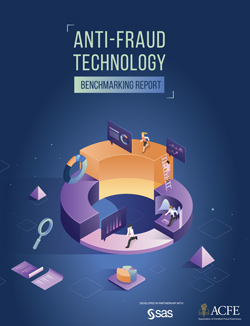The Future of Anti-Fraud Technology
/Technological advancements present opportunities for both fraud perpetrators and those trying to stop them. As criminals find new ways to exploit technology to commit their schemes and target new potential victims, anti-fraud professionals must ensure they are likewise adopting new technologies that are the most effective in navigating the evolving threat landscape.
But which technologies are most effective in helping organizations manage their fraud risk? Which tools provide benefits that outweigh the costs? How are organizations successfully harnessing the power of data and technology as part of their anti-fraud programs?
These issues were discussed in today’s roundtable session, “Benchmarking Your Use of Anti-Fraud Technology.” The answers to those and other questions can be crucial in gaining management buy-in and successfully implementing new anti-fraud technologies. Luckily, attendees were able to review the recently released Anti-Fraud Technology Benchmarking Report. A publication of the ACFE, the report was developed in partnership with SAS and serves as a road map to what the future technological landscape will hold.
Emerging technologies
According to the report, the use of artificial intelligence and machine learning as part of organizations’ anti-fraud programs is expected to almost triple over the next two years. Of the organizations surveyed, 26% currently use biometrics as part of their anti-fraud programs, with another 16% expected to deploy biometrics as part of their programs by 2021. But, what other emerging technologies can we expect to see implemented in the future?
While data analytics remains a popular tactic for preventing and detecting fraud, and is thoroughly discussed in the report, there are numerous other types of cutting-edge technologies that can be used to improve an organization’s ability to effectively and efficiently combat fraud. This includes technology like case management, digital forensics, robotics, blockchain and online evidence capturing.
Survey respondents were asked about their organizations’ current and expected use of several emerging technologies as part of their anti-fraud initiatives. The most common of these technologies currently being used to fight fraud is biometrics (e.g., fingerprint, facial or keystroke recognition). Both blockchain/distributed ledger technology and robotics, including robotic process automation, are currently used less frequently than biometrics (9% of organizations for both categories), but a similar proportion of organizations expect to implement these technologies in the next two years. The technology least likely to be adopted as part of anti-fraud programs is virtual or augmented reality; only 6% of organizations currently use this technology, and nearly two-thirds of the organizations in our study do not expect to employ virtual or augmented reality as part of their anti-fraud initiatives.
The challenges
While technological advancements can bring many benefits, adopting new technology often comes with challenges and potential barriers to success; anti-fraud technology is no different. The survey showed, and roundtable attendees echoed, that budget and financial concerns are the biggest obstacles for many organizations, with 80% noting this factor to be a major or moderate challenge. Other common challenges include limitations in staffing and in-house skill sets (73%), concerns about poor data quality or integration issues (70%) and a lack of perceived return on investment (69%).
But with challenges comes the commitment to remain ahead of fraud perpetrators. Of the organizations in the study, more than half expect to increase their budgets for anti-fraud technology over the next two years. This, along with the lively discussion today, is proof that organizations are proactively facing what is to come and choosing to arm themselves with the latest and most efficient technological tools available.
You can find more information and view the detailed report at ACFE.com/techreport.



